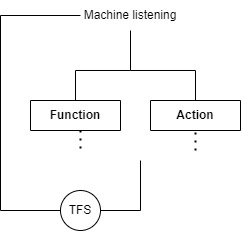When defining the kind of feedback, interaction, and process, the practice of sound precision became essential for the definition of a musical interface. The creation of Mappings is important for the design of controls (Norman, 2020). Through a long process of testing, trials, errors and eventual acceptance, each approach to music composition became not only sustained by a gesture but also ended with my own reaction to what I discovered. The design of Knurl's interface was a constant iteration of this relationship.
Ryan [Personal communication, 2018] once referred to electronic music as "black magic box", where the lack of representation and feedback can blur the listener’s or performer's expectations. A click can be the result of an instantaneous, late or anticipated event. In this sense, signals become a fundamental starting point for the design of mappings. A trigger of an action forms a relationship between the user and the machine, understanding each type of trigger and its application was therefore one of the starting points I needed to consider to design Knurl’s interface.
Knowing and visualizing the process of each action, it became easier to define the best strategies for a system. Different perspectives of mapping can generate a different context for a mechanism, affecting its relationship between the objects, network and hierarchy in that context. From a hierarchical point of view, conceptualizing a mapping affects design strategies for control, precision and focus (and these are applied to an instrument such as Knurl). Additionally, this is even more emphasized if a Network mapping has parameters that can become dynamic and interactive [van Nort, Wanderley, Depalle, 2019]. In the Knurl interface, I used mostly the evaluation of a trigger through time with touch buttons: if the button wasn’t triggered again in 2 seconds, then it resulted in an x action. In this way I could deal with different approaches from the signals according to each type of musical composition, or style and desired aesthetic.
When playing Knurl, the performer is able to reprogram their own system, allowing the performer to control multiple layers and voices at the same time (that are free from each other); moreover, the system is designed within a hierarchy where new possible controlling mechanisms can be achieved by navigating two main buttons that can controlled by a switch (these apply directly to Knurl’s functions and actions). Also, a machine listening system continuously tracks the performance of the music’s structure, allowing the system to run smoothly and not be burdened by high amounts of CPU usage. Lastly, the machine learning system also advises the performer about some possible musical structures [expand on this a bit more)
3.3.1. Practice
The practice of an effective system between a machine and musician is very related to the 2 main characteristics of a good design: discoverability and understanding. If the musician obtains the ability to discern the possible actions and how the product can be used, the system has a greater chance to be interpreted and performed well. One strategy to make that possible is to design a good feedback system.
In most interfaces, a feedback system isn't a necessary item to think about: a computer screen mostly becomes a visual feedback of the experience. However, in the case of Knurl, using a computer would defame the ability of the performer to focus on the global environment, such as reading scores can be argued to do in musical performances. I used touch sensor buttons with blue lights to avoid sound clicks into the music but also to offer an instantaneous light glance when pressed. When turned on, the instrument had also a heart beat blue light to reflect its health status.
However, in a musical instrument, feedback isn’t only represented by visual orientation, but mostly for tactile perception. Another practice to afford discoverability and understanding into a mapping is also related to the position of each feature and electronics. Analogue Slide potmeters became a suitable representation of finding those parameters.
3.3.2. Artistic Result
- The third Stuka. (Artwork)
This Undewater Stuka is one of the 3 last remaining original airplanes of the second world war that brought terrror to citizens by its loud sounds of areal bombs. Visiting this diving spot became a personal reflection between the power of nature against man. In the process of its composition, the form or mapping became an important role in defining the conflict between this relationship. During the piece, different actions and reactions reflect an interaction between a ganga choir and Knurl sounds. After studying and implementing the mapping of knurl´s interface, I was able to play this composition all along, triggering sound samples and also planning each sound layer to its form.
- ALGOMA5. Utrecht, Gaudeamus 2021
Since 2019, Timo Hoogland and I have been collaborating on the performance 'Hello off World!' where we can control each other's instruments in the performance. This summer at Gaudeamus 2021 CodeKlavier has also applied into a performance with Rafaele Andrade in the year 2021 to control and manipulate each other's instruments. We designed a performance representing false triggers that deals with the expectation of music parameters. The new interface design allows instruments like Codeklavier or live coding to manipulate or interact with Knurl by OSC messages. This mapping strategy allows musicians to communicate with each other through data, allowing their instruments to become signals for synthesis, triggering events and application of other artistic approaches.

